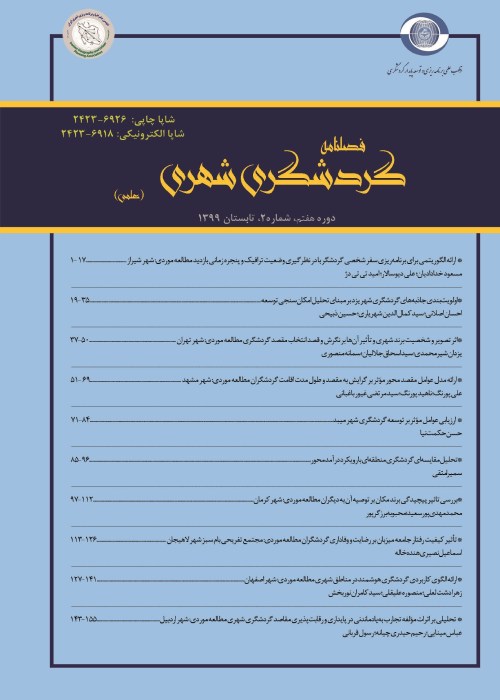Explaining the Effective Factors on the Attractiveness of Urban Tourism Destinations(Case study: Tehran metropolis)
A tourism destination is competitive if it can attract and satisfy potential tourists; this competition is determined by both specific tourism factors and a wide range of factors that affect tourism service providers, so many of these competitive efforts focus on destination advertising and destination development. The attractiveness of tourism destinations is one of the main factors in the competitiveness of tourism destinations. The main motivation for tourists to choose a place is according to their interests and preferences. The attractiveness of effective factor goals to achieve better economic conditions for the local community, as well as reflects a new mentality among people in one place. The concept of the attractiveness of destinations examines how social, political, economic, and environmental factors influence the promotion of competition in development. This study seeks to answer the following questions: -what factors affect the attractiveness of tourism destinations? -what is the structural model resulting from the attractiveness of tourism destinations?MethodologyIn terms of results, this research is considered as part of development research because it seeks to design a model of structural interpretive analysis of factors affecting the attractiveness of tourism destinations. In terms of purpose, this research is part of applied research. In fact, the research approach of this study is inductive-deductive in terms of data collection logic. For this purpose, first, by examining the theoretical foundations of the research, the effective factors on attractiveness of tourism destinations were identified, and based on the deductive approach, an attempt was made to design important and effective factors on the attractiveness of tourism destinations based on interpretive structural modeling. The data collection tool is a questionnaire based on an interpretive structural model. The statistical population was university professors and experts in the field who were selected by purposive sampling. Therefore, in this study, from a purposeful judgmental sampling (20 university professors and research experts) have been selected to conduct research. In the present study, in order to answer the research questions, the structural-interpretive modeling technique in MATLAB software environment has been used.Results and discussionThe findings of this study indicated that the structural model was classified into seven levels. The most effective level is the seventh one, which includes two factors such as natural landscape and infrastructure facilities. The natural landscape is considered as one of the main pillars of tourism so that tourism and the natural landscape are interdependent. The natural landscape forms many tourist attractions and the promotion and development of tourism in destinations depends on the natural landscape along with other factors. Also, along with the natural landscape, infrastructure facilities were identified as the most effective factor. Considering that nowadays, tourists are always looking for a quiet and pleasant place with desirable amenities, it can be done by providing services and infrastructure facilities such as accommodation, optimal transportation and creating a dynamic environment which can invite all members of society into the space of tourism destinations, create attractiveness of tourism destinations, and, consequently, provide the ground for attracting more and more tourists. This level directly affects the factors of the sixth level, i.e. welfare facilities. The sixth level also directly affects the fifth level, which includes proper access and environmental quality, and also, the fifth level affects the factors of the fourth level, as well as the fourth level on the third, the third level on the second, and finally the second on the first.ConclusionThe purpose of this study was to design an interpretive structural model of the effective factors on the attractiveness of tourism destinations using the ISM approach. The results of implementing the ISM model showed that the model includes seven levels. The seventh level is the most effective one, which includes two factors such as natural landscape and infrastructure facilities. Also, the results of leveling the identified factors showed that the highest level of mental image factors and the reputation and credibility of the destination have taken place. In other words, it can be said that the output resulting from the strengthening of the mentioned factors leads to a positive mental image of tourism destinations, as well as promoting the reputation and credibility of tourism destinations. The results of the implementation of the Mick Mac model showed that in the first area, the independent cluster, none of the identified factors were located, which indicates strong interactions and connections between the identified factors for the attractiveness of tourism destinations. In other words, it can be said that the interaction between the identified factors provides the basis for the attractiveness of tourism destinations. In the dependent cluster, i.e. the second area, environmental security factors, situation of reputation and credibility of the tourism destination, and mental image of the destination are located. It can be said that these factors are influenced by other ones; that is, other factors try to come these factors to fruition. In the third area, i.e. the cluster of factors of people's economic interactions with tourists, the shape and natural landscape, local community behaviour, special events, factors, amenities, environmental quality of the destination are located. The identified factors play the role of an intermediate factor, that is, they affect the stimulus cluster and affect the dependent cluster. The fourth cluster (stimulus cluster) are the factors of the amount of media advertising, appropriate access, attractive cultural and historical resources, and infrastructure facilities. Factors related to stimulus clusters have high impact power.
- حق عضویت دریافتی صرف حمایت از نشریات عضو و نگهداری، تکمیل و توسعه مگیران میشود.
- پرداخت حق اشتراک و دانلود مقالات اجازه بازنشر آن در سایر رسانههای چاپی و دیجیتال را به کاربر نمیدهد.



